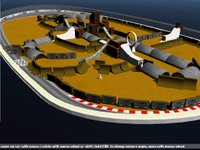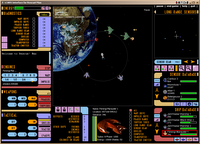Posted by John Hanke, Director, Google Earth and Google Maps We got so excited around here about the first anniversary of Google Earth that we decided to celebrate a bit early. Beginning today, you can
download a brand new version, Google Earth 4. Running on OS X? Feel the love. Prefer Linux? Ditto. Yes, we're releasing simultaneously for PC, Mac (universal binary for full performance on both Intel and PowerPC based Macs) and for the first time ever, native support for popular Linux distributions. And we should say "salut," "ciao," "hallo," and "hola" to our French, Italian, German and Spanish users, because Google Earth is now fully localized for those languages in addition to English. This includes a UI localized to French, Italian, German, and Spanish, as well as local search, driving directions, geo-coding, and unique local information layers for those countries.
Got data?The streamlined new UI is bound to make you crave new places to explore, so we put together a little update to our database — we increased our global coverage by about 4X. Google Earth now covers more than 20 percent of the landmass of the entire globe with high-resolution satellite imagery (soon
Google Maps will too). When we say "high resolution," we mean the good stuff: you can see cars, houses, buildings in more than 200 countries and territories. Not every house is covered, only about two billion of them. That's our best estimate, anyway — that about 1/3 of the population of the Earth can now see their homes in high-resolution. Google Earth has had medium resolution global satellite coverage since the beginning. But that was at 15 meters per pixel. This new global coverage was produced in conjunction with our exclusive satellite partner, Digital Globe, and is at approximately 70 cm per pixel. We have even better data for many countries, up to 10 cm per pixel.
What global insights can this new data produce? Google Earth has already helped save tsunami, hurricane, and earthquake victims, not to mention find a
lost Roman villa, track
severe storms, discover
new meteor craters, track the
outbreak of avian flu, visually index
magazine articles and photos, host
travel videos, redefine the
house-shopping process, track
airplanes in flight, recognize every
Medal of Honor recipient, and many other uses we never expected. Only time will tell what it will bring, and it will only be fully realized when energetic and creative people use powerful tools like KML to exploit the new data and features.
Why not KML in Maps?We asked that too.
KML is such an amazingly flexible way to create and share geographic information - whether it's
sharing vacation photos with your friends or publishing important data like the
realtime earthquake feed from the U.S. Geological Survey — we thought it would be useful to be able to view KML in Google Maps. So here it is! You can now view KML in Maps by entering the URL for your KML file. To browse hundreds of thousands of interesting KML files, see what the half million members of the
Google Earth Community have created.
Feeling inspired?Google SketchUp and
Google 3D Warehouse have enabled creative individuals around the world to model their world in 3D. A
new version of SketchUp is available today that enables the export of fully-textured 3D models to 3D Warehouse and Google Earth. This will bring even more realism to the collectively-authored 3D world SketchUp users are creating.
Ready to mashup?Our legion of Maps API developers asked us to support
geocoding. So we decided to push that out today too. Street-level geocoding is now available for the U.S., Canada,
Japan, France, Italy, Germany and Spain. Let the mashing begin.
Correction: Street-level geocoding is not available in Japan.
Are you enterprising?Finally, now there's
Google Maps for Enterprise, offering a fee-based service and support for businesses that want to embed a Google Maps experience in their websites or internal applications. It leverages the
Google Maps API to enable businesses to map customer locations, track shipments, manage facilities or view any other data source in a geographic context.
Whew. I'm exhausted from writing all of that. Our first year has been a busy one. We hope you enjoy these latest efforts in our mission to geographically organize the world's information and make it universally accessible and useful.
 It's an easy way to identify fast, secure places to shop when you search. And after you've placed your order, Google Checkout provides a purchase history where you can track your orders and shipping information in one place.
It's an easy way to identify fast, secure places to shop when you search. And after you've placed your order, Google Checkout provides a purchase history where you can track your orders and shipping information in one place.




































